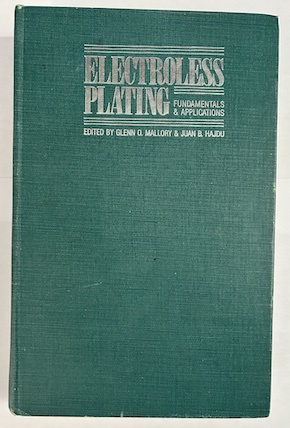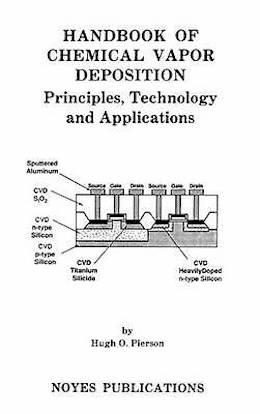
Curated with aloha by
Ted Mooney, P.E. RET

The authoritative public forum
for Metal Finishing 1989-2025

-----
Expected variation in plating and anodizing thickness?
Q. I am working with various electroplating companies to coat nickel on thin sheets of material that are roughly 48" x 48" x 0.06" thick. Aim is to get 200 (+100, -0) microinches of plating thickness. Edges are masked to prevent material build-up. Nevertheless, I'm told thickness variation can be as much as 400 microinches across the entire surface.
Is this reasonable?
Can this be controlled better (± 50 microinches)?
How can one accurately measure the variation non-destructively?
David K [last name deleted for privacy by Editor]- Columbus, Ohio
2001
A. It would take thieves and shields to do it and that can be a large pain. Simplest is to just use electroless nickel. Costs more, but is superior in nearly every way.
James Watts- Navarre, Florida
2001
Q. One problem with electroless nickel is that its melting point is below 1000 °C ---bad news for me. I've got to have the electrolytic. So ... can you control electrolytic nickel plating to ± 50 microinches?
Suggestions for sources?
David K [returning]- Columbus, Ohio
2001
A. Dave:
It can be done by means of a time consuming preparation work of anode placing and thieves (something most platers just hate) and a good help from statistical laws (cross fingers). There are two other ways also expensive but worth exploring. Electroless nickel- boron (melting point is 1,080 °C) and over plating and then grinding your actual electro-nickel.
Good luck,
Guillermo MarrufoMonterrey, NL, Mexico
2001
----
Ed. note: The site's supporting advertiser Hill-Cross Company [a finishing.com supporting advertiser] is a job shop with highly specialized experience in Nickel Boron plating.
A. I agree. Thieves and shields take a lot of trial and error. This will cost a chunk of change! Virtually any good plating book will have a chapter on this subject. AESF (www.nasf.org) has a neat pamphlet for sale on this subject.
What causes it is a science. How to correct it is an art.
James Watts- Navarre, Florida
2001
2001
A. The thickness variation is often a problem resolved by subsequent grinding. When we use the Chemical Vapor Deposition process to grow nickel shapes, or coatings on complex pieces, the variation can be only as close as ± 0.005 inch. The main variable is the uniformity of heating of the substrate (to 350 °F) for the CVD process, but the nickel does grow very fast - at a rate of 0.010 inch per hour.
Cheers,

Mick O'Meara
- Toronto, Canada
A. Hi. If you look at the making of electroforms for vinyl record stampers and CD molds, while they use shields, they also rotate the mandrel on a central shaft. That sounds strange for a 48" x 48" rectangular item, but in theory it can certainly be done.
The question is usually not what is possible but what is economically feasible. Certainly ± 50 microinches is possible. It should also be noted that the thickness will be in proportion to the amp-hours (in accord with Faraday's Law), and the current distribution can be designed and investigated with specialty software to aid in placing the shields and the anodes.
Regards,

Ted Mooney, P.E.
Striving to live Aloha
finishing.com - Pine Beach, New Jersey
November 2013
Plating thickness variation in barrel nickel plating
Q. We do barrel nickel (Bright nickel) plating for specification of 5-7 microns of nickel thickness, on automotive keys (brass). We always get nickel-thickness variation of 2-3 microns in individual pieces from both sides and variation of 3-4 microns in each lots. We would like to get input on any other alternative methods by which thickness variation could be minimised to our acceptable limits.
Your feedback will be highly appreciated.
With regards,
Subhash Chandra jhaplating shop - NOIDA (U.P.), INDIA, UTTER PRADESH, INDIA
2004
A. I would first make sure that the holes in the barrel are still fully open. You might want to consider drilling them out slightly oversize to increase the solution flow into the barrel. If that does not help enough, consider dropping the amperage per load and plating slightly longer. Also keys are flat and you may be "ringing" or the keys stick together for a period preventing a uniform plating. Adding conductive balls to the load and adjusting the amperage sometimes works. Does your barrel have proper sized "bumper strips" on the inside to cause a stronger mixing of the keys. You might also have to reduce the load size (and the amperage) to get better mixing. You are always going to have some of this problem with flat parts, but you can influence how bad the problem is.
James Watts- Navarre, Florida
2004
A. It is very difficult to accurately control the deposit thickness in barrel plating as it cannot be shielded. The best option is to carefully control the surface area and shape of the component. As long as you have the same component in the barrel and the same surface area and you apply the same total current, the thickness variation between parts and batches will be very similar. That is not to say that the thickness distribution over an individual component will be constant, but hopefully it will be reasonably reproducible.

Trevor Crichton
R&D practical scientist
Chesham, Bucks, UK
2004
A. Hi
I can recommend to increase the solution flow in to the barrel, with better agitation or put small wings on the drums which press the solution in to the drums. In other case, it's possible to increase thechloride content to getbetter metal distribution.
Jan Malmquistfinishing shop - Huskvarna, Sweden
2004
How to achieve Uniform nickel plating thickness
Q. We have a nickel sulfamate bath (600 grams of Nickel sulfamate, 40 grams boric acid per liter)INCO S nickel pellets rounds 10 mm diameter, filtering 20 microns + agitation-recirculation pump. We plate 330 x 530 mm shims and we use only one titanium anode bag of 320 x 220 mm. We experience thickness variation of the shim like: edges 95 microns center 65 microns. Distance between anode and cathode is 260 mm.
How can we reduce the variation in thickness?
We can enlarge for example the distance between anode and cathode up to 400 mm. Will that help or we need to have a custom size anode bag and what will be the best size?
engineer, hologram manufacturer - Bucharest, Romania
November 28, 2009
A. There are several ways of approaching the problem, which if you consult a good plating book, you will find it rather common.
The simplest approach is to move the anode back as far as you can from the shim. This will help some, but not enough, so make a shield out of polypropylene or polyethylene ( you could use PVC, but it would have to be thicker) This shield will look like a picture frame and will be about 70 mm frame height or "the size that a wood picture frame would be. Make the outside dimensions 20 mm larger than the shim size in both length and width. Hang this shield , centered, about 10 to 30 mm in front of the shim. I would start with 20 mm. the closer the shield to the shim, the more it will reduce the edge buildup. Too close and you will get a hump a bit away from the edge.
You do not say what current density that you are using, but I would look at the possibility of lowering the amperage 10% and plating 10 % longer.
The last resort is to attach a thief or robe to the ID of the frame out of SS and attach it to the cathode rod.
- Navarre, Florida
November 30, 2009
A. You have to either customize your jig (by shielding partially the edge of the part) or customize your anode (by additional anode which put closer to the center of the part,although this is achievable but practically hard to operate)
John Hu- Singapore
November 30, 2009
Q. We plate 2 Amps for 15 minutes then 5 Amps for 15 min. and then 20 Amps for 4.5 hours. The thickness difference that we are complaining is not at the edge of the shim. The measured values are at least 5 cm (2") away from the edges that we cut away after plating. The listed variations are from center of shim to at least 5 cm away from the edges. Edges are much thicker but we cut and throw away afterward. The problem is how to make the thickness uniform, edges are not important.
Mihai Necsulescu [returning]- Bucharest, Romania
December 2, 2009
A. Hi, Mihai. The fact that you cut away the edges does not change what the previous responders have told you. Electroplating is an electrochemical reaction that proceeds in direct proportion to the current density at any point and you can change that current density with a shield.
Take a sheet of thin (say 5 mm) PVC or polypropylene at least 330 mm x 530 mm and drill a good number of 5 cm dia. holes through it, but none near the edges. Place it between the anode and cathode, probably several centimeters from the cathode, and proceed with the plating. Measure the thickness variation of the plating and adjust the location and size of the shield and holes until the plating thickness variation is acceptable. Good luck.
Regards,

Ted Mooney, P.E.
Striving to live Aloha
finishing.com - Pine Beach, New Jersey
December 2, 2009
High thickness variation in ammonium chloride zinc barrel plating
2003Q. Hello,
I am facing following problem at our plating shop -
We are plating screws of different sizes like 1", 2", 3" & these screws are heat treated. The process is "ammonium chloride based acid zinc plating". The parameters kept for above process are as follows -
Chloride: 180-200 g/l, pH: 5.4-6.0, Zinc: 30-40 g/l, Anode:Cathode ratio: 1:6, Barrel load: 50 Kgs (12 sq.m.),Current: 0.5 to 0.7 amp/sq.dm., Voltage: approx. 10 volts, Barrel speed: 7-9 rpm, Hole size of barrel: 1 mm,
Coating thickness: Head portion - 10 microns, Shank portion - 6 microns, point portion - 50 microns.
Process Sequence -
Degreaser - Alkaline degreaser - 70 °C, 7-8 min.
Water Rinse - RT, 1 min.
Anodic cleaner - RT, 7-8 min.
Water Rinse - RT, 1 min
Acid Pickling - HCl - 30-50% v/v, RT, 5-7 min.
Water Rinse - RT, 1 min.
Mild Acid rinse - HCl, 5% v/v, RT, 1 min.
Electroplating - As per above parameters (Time - 1 to 1:30 hr, as per surface area loaded)
Water Rinse - RT, 1 min.
Water Rinse - RT, 1 min.
Passivation - RT, 10-15 sec.
Water Rinse - RT
The addition of Carrier & brightener is done as per production volume or amp-hr basis.
Kindly let us know the reasons for the above problem.
Regards,
Santosh Zope- Mumbai, Maharashtra, India
A. Dear Santosh.
1. Increase hole dia. to 4-5 mm or as large as your screw dia. will allow.
2. Increase RPM to Minimum 14-16.
3. Reduce metal content to 20-22 grams and chloride to 110.

Khozem Vahaanwala
Saify Ind
Bengaluru, Karnataka, India

2003
Q, A, or Comment on THIS thread -or- Start a NEW Thread

